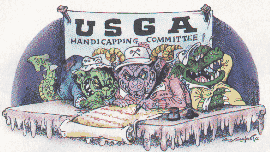|
A formula for slow play and higher scores
Jerry Tarde

The sillies at the U.S. Golf Association have their hearts in the right place, but every couple of years they do something so exceedingly silly that you think their blue blazers should be sewn shut at the cuffs.
They outlaw the paddle grip Ben Crenshaw has had on his putter since high school, and then they approve the broom-handle putter Orville Moody now dangles from his chin.
They declare that the only way to break a tie in the U.S. Open is with an 18-hole playoff, but then they say the only way to break a tie in an 18-hole playoff is with sudden-death.
Their latest act of silliness goes by the call letters ESC, standing for Equitable Stroke Control. ESC puts a lid on the maximum number of strokes you can record for handicap purposes. It used to mean that you could take as many double bogeys as the number in your handicap. If your handicap was over 18, you could take as many triple bogeys as your handicap exceeded 18. Every golfer I know grasped the concept.
The USGA conducted its own survey and determined that 75 percent of all golfers were doing it wrong. The Governing Body is a little sketchy on how it arrived at the 75 percent figure. I, on the other hand, am happy to submit a list of my friends and acquaintances to anyone who sends a self-addressed stamped envelope.
With this mandate, the USGA sillies set out to devise a new, improved formula. Their ESC now disregards par and sets a maximum score to be posted on any hole as follows:
for course handicaps (not indexes) of 9 or less, your limit is 6;
for 10 through 19, it's 7;
for 20 through 29, it's 8;
for 30 through 39, it's 9;
for 40 through 49, it's 10;
for 50 and above, it's 11.
The USGA backs up the new ESC with several arguments. It's simpler and easier to understand, they say. This is the same organization talking that just brought you the Slope System, a logarithmic function we]1 intentioned though it may be, but so incomprehensible you must now employ a team of mathematicians from M.I.T. at thc club to figure out the bets. "Certainly more golfers understand the old ESC system than can explain Slope," says one of my acquaintances (name upon request).
The new ESC is more equitable for high handicappers because the old system often would not allow average scores to be posted on difficult holes, they say. It's true the old ESC was slightly biased against a short hitter on long courses. But the new ESC seems to reward a player for truly abysmal scores. "It sets up an incentive system detrimental to promoting good golf," says a friend.
The old ESC causes unfairly low handicaps just below the breakpoints, they say. On the contrary, the new ESC does not eliminate the breakpoint inequities, but actually increases their possibility and size.
"If my index is 7. 5 at my club I have a 9-handicap, and if it is 7.6 I have a 10," writes a pal of mine. "Under the old system I could have nine double bogeys maximum if my handicap was 9, and I could have 10 if my handicap was 10 � a one-stroke difference. Now I can have a maximum of six strokes per hole with the 9-handicap, but with the 10 I can have seven on each hole 18 strokes difference. With an increase of only 1/10th of a point in the index, I can have four quadruple bogeys, 12 triple bogeys and two double bogeys, instead of thc old 10 double bogeys."
In the USGA's defense, my pal's high rounds probably will be thrown out anyway and the change in his handicap will be minimal. But people who are 9s will have a hard time ever getting to 10, even when they deserve to.
Some critics will say that the new ESC makes it easier for sandbaggers to pad their scores, but my biggest argument against it is pace of play.
Don't worry about slow play, they say. Well, a 30-handicapper used to pick up after six strokes on a par 3; now he picks up after nine. Nine! High handicappers can play as fast as low handicappers, they say. "Doesn't it take the same player longer to play nine strokes than five?" asks a buddy. "Playing out a 9 will be as painful as it is time-consuming."
No, golfers don't have to play to the maximum, they say. You can pick it up after you've lost the hole and "jot down the score you likely would have made."
Excuse me? I'm supposed to estimate what I would have done if I had continued playing out? Perhaps the USGA does not understand the unpredictability of a golfer's nature.
So I make a telephone call to the USGA to ask how one does this. It is only the first week in April, but 2,000 others have already called about the new ESC system, mostly to complain, but some, like me, just to ask how one estimates a score one hasn't scored.
"We tell people not to assume your best shot, but to guess on the basis that you're not going to get into any more trouble," they say, thereby putting the ESC system into a new perspective.
"Oh," I say, "how silly of me."
|




